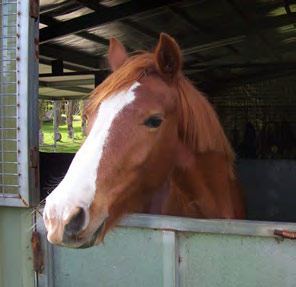Over the stable door
Greetings Fellow Equines and Horse Owners!
By now the paddocks are well and truly wet through, at least in the hills. Although everything looks lovely and green, it comes with its problems. When the weather is not so cold and there are many wet areas, our horses can be prone to many hoof conditions. Some of the conditions which can affect your horse include seedy toe, thrush and greasy heel (or mud fever). All of these can be slow to clear up, so preventative maintenance is the go.
Seedy toe
Seedy toe is when the hoof wall separates from the sole at the toe. When you pick up the hoof, there will be a black area where the separation is. This black area hides a cavity that runs up inside the hoof wall. If you tap the wall of the hoof it will sound hollow. In severe cases the horse will be lame. Causes range from hard work on hard ground, especially in a horse with weak hoof walls to begin with (as is common in many thoroughbreds), poor shoeing, or leaving the shoes too long between shoeing (this causes the toes to get too long and weakens the wall), small stones getting wedged in between the shoe and hoof, or sometimes with founder, (where the hoof wall is at risk to begin with). It needs to be cleaned out and disinfected on a daily basis and kept as dry as possible. Seek veterinary advice if in doubt.
Thrush
Thrush is a bacterial infection in the grooves on either side of the frog. The first thing you will probably notice if your horse has thrush is the smell – it is quite strong and pongy! The area will have a black sticky discharge on each side of the frog and your horse may even be lame with this, if severe. Causes can be mainly from the horse standing for long periods of time in wet, boggy (or even urine soaked) areas and not getting a chance to dry out. Even lazy attention to detail when cleaning out feet can contribute to thrush. If you are not sure what to do, your vet can do this, but basically the area needs to be thoroughly cleaned out, including al the sticky smelly stuff. Again, it needs to be disinfected and kept dry. The frog is important for the health of the hoof, so it is important to get on to this straight away, as corrective shoeing may be needed if the frog is too unhealthy. Again seek veterinary advice if in doubt.
Greasy heel (mud fever)
Greasy heel (mud fever) is a dermatitis condition affecting the skin usually at the back of the pasterns and down to the heels. It tends to be more common in horses which have pink skin (usually with white hair) in these areas. And it also seems to be more common on the hind legs, but can still affect all four. The affected area can be extremely painful, with broken skin, swelling, scabs and bleeding. The horse will be very uncomfortable when asked to flex those joints when you are cleaning out the feet. In extreme cases, the horse can also be lame. Again, wet or muddy conditions (even too much hosing in the summer), with the area not getting a chance to dry out, or not being dried off properly after hosing, will all contribute to this condition. Other less common causes include rope burns, or too much hard work in deep sand. The area needs to be cleaned and kept dry – on a daily basis preferably. This condition does not clear up overnight! There are a few creams on the market which can be applied regularly. One is Zinc cream, but there are others. Veterinary advice is advisable if not clearing up with treatment.
The bottom line is, ‘No ‘oof no ‘orse’, so regular and thorough hoof cleaning is a given, even if the horse is not being ridden.
So good luck with those feet everyone, and safe riding!

